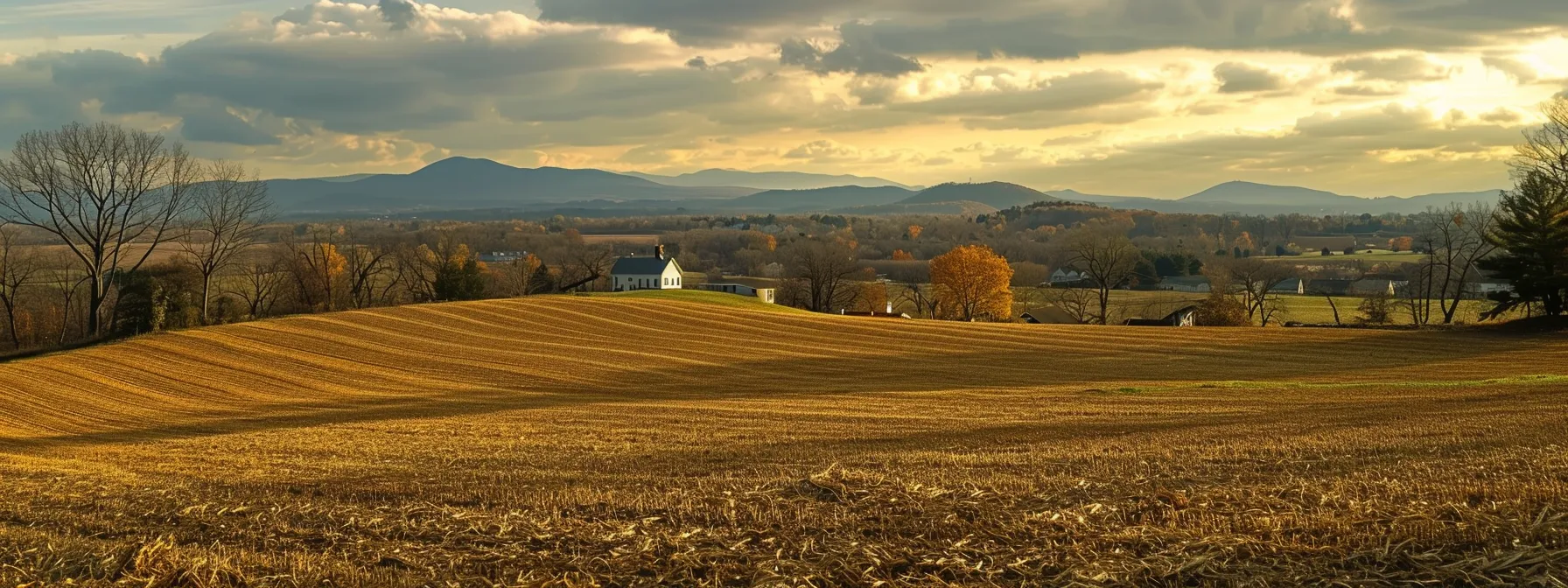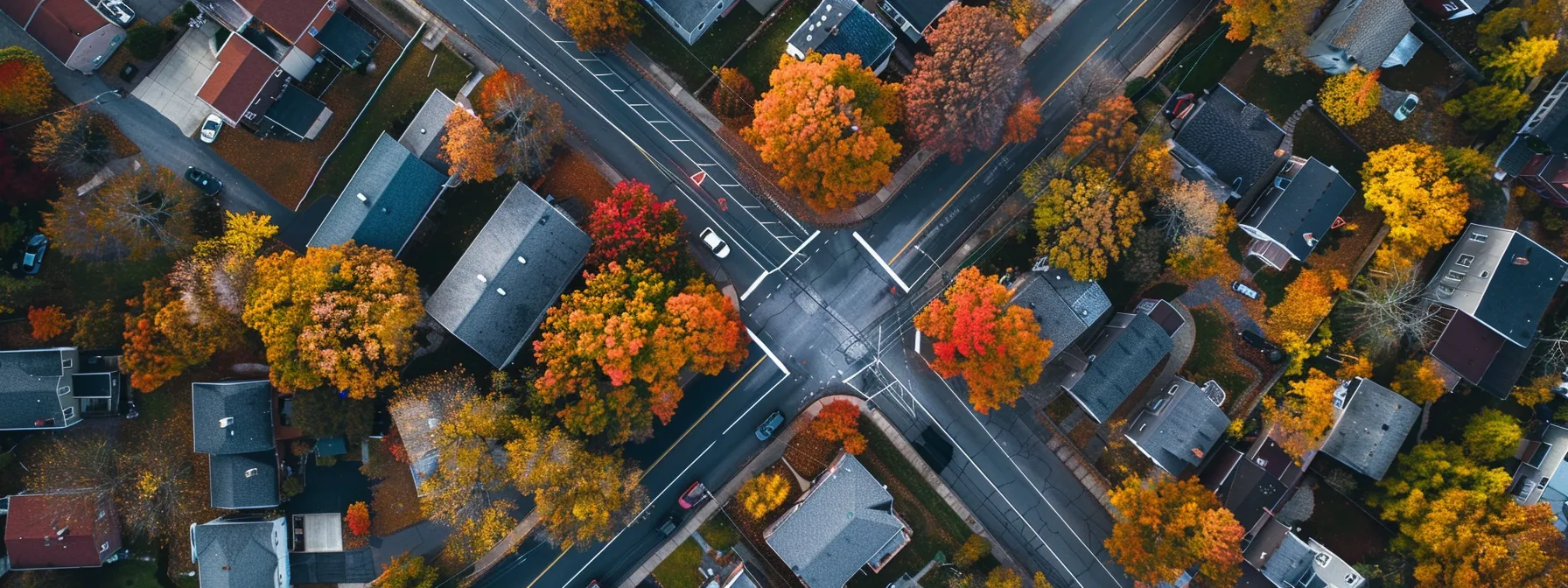
What to Look for in a Building Lot: The Non-Negotiables for Your Dream Home in Maryland
Finding the perfect building lot can make or break your custom home project. Many families spend months planning their dream home, only to discover their chosen lot has hidden problems that cost thousands in unexpected expenses.
As custom home builders in Maryland for over 60 years, Woodbridge Homes has helped hundreds of families select the perfect building lots for their dream homes. This guide will teach you exactly what to look for in a building lot to avoid expensive surprises.
You’ll learn the non-negotiable factors that determine whether a lot is suitable for your custom home, how to spot red flags, and which features add long-term value. By the end of this article, you’ll have the knowledge to evaluate any building lot like a professional.
Essential Location Factors: What to Look for in a Building Lot’s Neighborhood

Location determines more than just your daily commute. The right neighborhood affects your family’s lifestyle, your home’s future value, and your overall satisfaction with your building lot choice.
School District Quality and Its Impact on Your Building Lot Investment
Quality schools significantly impact building lot values, even if you don’t have children. Lots in top-rated school districts typically appreciate faster and maintain value better during market downturns.
Research test scores, graduation rates, and college acceptance rates for the district. Check if the schools are overcrowded or if new schools are planned. Many Maryland counties provide online tools to check school assignments by address.
Proximity to Amenities When Selecting Your Building Lot
Consider your family’s lifestyle when evaluating building lot locations. Do you need easy access to shopping, dining, or recreational facilities? Think about medical facilities, especially if you have aging parents or health concerns.
Don’t forget about everyday conveniences like grocery stores, banks, and gas stations. A building lot that seems perfect might d appeal if simple errands require long drives.
Future Development Plans That Affect Building Lot Values
Research planned developments that could impact your building lot’s value and enjoyment. New shopping centers might add convenience but also traffic and noise.
Check with local planning departments about proposed roads, commercial developments, or industrial projects. Look for positive developments too, like new parks or upgraded schools that can boost your building lot’s value.
Transportation Access and Commute Considerations for Your Lot
Evaluate commute times during actual traffic conditions, not just off-peak hours. Drive the route during your typical work schedule to understand real travel times.
Public transportation access matters even if you don’t currently use it. Building lots near transit options typically hold value better and appeal to more buyers if you sell.
Physical Characteristics: Critical Features to Look for in Every Building Lot
The physical features of your building lot determine construction costs, design options, and long-term maintenance requirements. These characteristics are often expensive or impossible to change.
| Lot Feature | Ideal Conditions | Red Flags | Impact on Costs |
|---|---|---|---|
| Slope | Gentle slope (2-10%) for drainage | Steep slopes over 20% | Moderate to High |
| Soil Type | Well-draining clay/loam mix | Rock, expansive clay, or sand | Low to High |
| Size | Adequate for home plus setbacks | Too small for desired home size | Low |
| Shape | Regular rectangle or square | Narrow, irregular, or oddly shaped | Low to Moderate |
| Drainage | Natural drainage away from home site | Standing water or poor drainage | High |
Lot Size and Shape Requirements for Custom Home Construction
Your building lot must accommodate your desired home size plus required setbacks from property lines. Many buyers underestimate the space needed for driveways, landscaping, and outdoor living areas.
Irregular lot shapes can limit home design options and increase construction costs. Consider future needs when evaluating lot size, such as pools, workshops, or RV parking.
Topography and Slope: How Land Features Impact Your Building Plans
Gentle slopes provide natural drainage while minimizing construction complexity. Building lots with 2-10% slopes typically offer the best balance of drainage and building ease.
Steep slopes create dramatic views but require expensive foundation work and retaining walls. Building costs can double on lots with slopes over 20%. Flat lots may have drainage problems requiring more extensive drainage systems.
Soil Conditions Every Building Lot Buyer Must Evaluate
Soil conditions determine foundation costs and long-term home stability. Rocky soil requires expensive excavation, while soft clay may need special foundation designs.
Always require a professional soil test before buying any building lot. This relatively small investment can save thousands in construction costs and prevent future foundation problems.
Drainage and Water Management on Your Potential Building Lot
Poor drainage causes foundation problems, basement flooding, and landscaping issues. Water should naturally flow away from your planned home location.
Look for signs of standing water, especially after rain. Check if neighboring properties drain onto your potential lot. Consider seasonal drainage patterns too, as spring snowmelt and summer storms can create problems.
Utility Access and Infrastructure: Building Lot Essentials You Can’t Ignore
Utility availability significantly impacts both building costs and daily living convenience. Some utilities are expensive to extend, while others may be impossible to access.
Electrical Service Availability for Your Building Lot
Verify that electrical service reaches your building lot boundary. Extending power lines costs thousands of dollars per pole, making distant lots more extensive to develop.
Check the electrical service capacity available. Large custom homes need 200-amp or higher service, which may require utility company upgrades in older areas.
Water and Sewer Connections: What Building Lot Buyers Need to Know
Municipal water and sewer connections provide convenience and reliability but come with monthly costs and connection fees. Verify these services reach your building lot before purchasing.
Rural building lots often require wells and septic systems. Septic systems need suitable soil conditions and adequate space. Rocky or clay soils often fail percolation tests required for septic approval.
Natural Gas and Internet Service Access on Building Lots
Natural gas provides efficient heating and cooking but isn’t available everywhere. High-speed internet access is essential for most families today. Verify that cable or fiber service reaches your building lot.
Consider future utility needs too such as electric vehicles and home offices. Electric vehicle charging requires adequate electrical service and home offices need reliable internet with good upload speeds.
Zoning and Legal Considerations: Building Lot Restrictions to Research

Legal restrictions determine what you can build and how you can use your building lot. These rules protect property values but may limit your plans.
| Restriction Type | What It Controls | Where to Check | Potential Impact |
|---|---|---|---|
| Zoning | Building use, size, height | County/city planning office | High |
| Setbacks | Distance from property lines | Zoning records, surveys | Moderate |
| HOA Covenants | Architectural standards, landscaping | HOA documents | High |
| Easements | Utility/access rights | Property deed, survey | Low to High |
Zoning Classifications and What They Mean for Your Building Lot
Zoning determines what types of buildings are allowed and how large they can be. Check if your building lot’s zoning matches your intended use. Zoning changes are possible but expensive and time-consuming.
Setback Requirements and Building Restrictions on Your Lot
Setbacks require buildings to be certain distances from property lines, roads, and water features. These requirements effectively reduce your buildable area and may limit home designs.
Height restrictions limit home size and design options. Some areas restrict homes to one story, while others allow multi-story construction with specific height limits.
Homeowner Association Rules That Impact Building Lot Use
HOA covenants often impose stricter rules than zoning requirements. Review all HOA documents before buying your building lot. Consider HOA fees and their impact on your budget.
Easements and Property Rights Every Building Lot Owner Should Understand
Easements give others rights to use portions of your building lot for utilities, access, or drainage. Review the property survey and deed to identify all easements that could impact your building plans.
Environmental Factors: Natural Elements to Look for in a Building Lot
Natural features affect your home’s comfort and long-term maintenance requirements. Make sure to review these factors as they are impossible to change after purchase.
Mature Trees and Natural Features That Add Value to Building Lots
Mature trees provide shade, privacy, and aesthetic appeal that take decades to develop. However, large trees near building sites can complicate construction and require expensive removal.
Balance the benefits of mature landscaping with construction practicality. Sometimes the best building lots have trees in the right places rather than the most trees overall.
Flood Zones and Environmental Hazards to Avoid When Selecting Lots
Flood zones require expensive flood insurance and may limit financing options. Check FEMA flood maps for your potential building lot.
Research other environmental hazards like steep slopes prone to erosion or areas with frequent lightning strikes. These factors affect insurance costs and safety.
Cost Considerations: Financial Factors When Evaluating Building Lots
Understanding all costs associated with building lot ownership helps you budget accurately and avoid financial surprises.
Site Preparation Costs That Vary by Building Lot Type
Level lots with good soil require minimal site preparation, while sloped or rocky lots need extensive work. Clearing trees, grading, and installing utilities can cost tens of thousands of dollars.
Consider accessibility for construction vehicles. Remote lots may require temporary road improvements or special equipment that increases construction costs.
Utility Connection Fees and Infrastructure Costs for Your Lot
Municipal utilities charge connection fees that vary widely by location and distance from existing lines. Rural lots requiring wells and septic systems have different cost structures.
Research all utility connection requirements and costs before committing to any building lot. These expenses significantly impact your total project budget.
Long-Term Property Taxes and Ongoing Costs of Building Lot Ownership
Property taxes vary by location and assessed value. HOA fees add ongoing costs that can increase over time. Consider maintenance costs for private roads, wells, and septic systems with rural building lots.
Red Flags: Warning Signs to Avoid When Looking at Building Lots
Some building lot problems are expensive to fix or impossible to overcome. Learning to recognize these red flags helps you avoid costly mistakes.
| Red Flag | Why It’s Problematic | Potential Solutions | Cost Range |
|---|---|---|---|
| Standing water after rain | Foundation and drainage issues | French drains, grading | $5,000-$25,000 |
| Extremely steep slopes | High construction costs | Retaining walls, special foundations | $20,000-$100,000+ |
| Poor road access | Construction and emergency access | Road improvements | $10,000-$50,000 |
| Rock outcroppings | Expensive excavation | Blasting, alternative foundation | $15,000-$75,000 |
| Nearby industrial facilities | Noise, pollution, property values | None – avoid these lots | N/A |
Drainage Problems That Make Building Lots Unsuitable
Standing water indicates poor drainage that can cause foundation problems and basement flooding. Look for water stains on existing structures, muddy areas that don’t dry out, and vegetation that indicates wet conditions.
Access Issues That Complicate Building Lot Development
Narrow or steep driveways limit construction vehicle access and increase building costs. Verify that emergency vehicles can reach your building site.
Soil Problems That Increase Construction Costs on Building Lots
Rocky soil requires expensive excavation and may limit foundation options. Expansive clay soils swell and shrink with moisture changes, potentially damaging foundations.
Legal Complications That Can Derail Your Building Lot Purchase
Unclear property boundaries can create disputes with neighbors and delay construction. Always verify boundaries with a current survey before purchasing any building lot.
Working with Professionals: Expert Help When Choosing Your Building Lot
Professional guidance helps you avoid costly mistakes and identify opportunities you might miss.
The Role of Real Estate Agents in Building Lot Selection
Look for agents who specialize in land sales rather than general residential sales. Building lot transactions have unique considerations that require specific expertise.
When to Hire a Surveyor for Your Potential Building Lot
Surveys show exact property boundaries, easements, and topographic features. Consider getting a new survey for any building lot purchase, especially if the existing survey is more than a few years old.
How Custom Home Builders Evaluate Building Lots for Clients
Experienced builders like ourselves can estimate construction costs based on lot conditions and identify potential problems before you buy. We offer a free site evaluation for those who own a lot or are considering the purchase of a lot.
Professional Inspections Every Building Lot Buyer Should Consider
Soil tests reveal foundation requirements and septic system feasibility. Environmental assessments identify potential contamination or other hazards. Percolation tests determine septic system feasibility.
Making Your Decision: How to Evaluate and Compare Building Lots
Systematic evaluation helps you compare different building lots objectively and make informed decisions that align with your priorities and budget.
Start by creating a checklist of your must-have features versus nice-to-have features. Visit potential lots multiple times under different conditions. Consider the total cost of ownership, including purchase price, development costs, and ongoing expenses.
Don’t rush your decision. Building lot purchases are significant investments that affect your family for years.
Frequently Asked Questions About What to Look for in a Building Lot
What’s the ideal size for a custom home building lot?
Lot size depends on your home size, local setback requirements, and desired outdoor space. Generally, aim for at least 0.5 acres for custom homes. Consider setbacks, septic system requirements, and desired amenities when determining adequate size.
How important is the shape of a building lot for construction?
Lot shape significantly affects construction costs and design options. Regular rectangular or square lots offer the most flexibility and lowest costs. Narrow or irregular lots may require custom designs that increase construction expenses.
What soil tests should I require before buying a building lot?
Require a professional soil test that evaluates bearing capacity, drainage, and composition. For rural lots, also get percolation tests for septic systems. These tests cost a few hundred dollars but can save thousands in construction costs.
How do I verify utilities are available to my building lot?
Contact utility companies directly to verify service availability and connection costs. Don’t rely on seller representations alone. Get written confirmation of service availability and connection fees from each utility provider.
What questions should I ask about building lot restrictions?
Ask about zoning requirements, setback rules, height restrictions, and architectural standards. Review HOA covenants if applicable. Check for easements that might limit building placement.
How much should I budget for site preparation on my building lot?
Site preparation costs vary widely based on lot conditions. Budget $5,000-$15,000 for level lots with good access, but costs can exceed $50,000 for challenging sites requiring extensive work.
What are the biggest mistakes people make when selecting building lots?
Common mistakes include not researching zoning restrictions, underestimating development costs, ignoring drainage issues, and failing to verify utility availability. Always conduct thorough due diligence before purchasing.
How do I know if a building lot is a good investment?
Good building lots are in desirable areas with quality schools, reasonable development costs, and strong resale potential. Consider total ownership costs, not just purchase price, when evaluating investment potential.
Making the Right Choice for Your Building Lot Investment
Selecting the right building lot requires careful evaluation of location, physical characteristics, utilities, and legal restrictions. The perfect lot balances your current needs with long-term value and usability. Remember that some problems can be fixed while others cannot. Focus on finding lots with good fundamentals – proper drainage, suitable soil, and adequate access. These basics are expensive or impossible to change after purchase. At Woodbridge Homes, we’ve helped Maryland families evaluate and select building lots for over 60 years. Our experience helps clients avoid common pitfalls and find lots that work perfectly for their custom home plans.

Leave a Reply